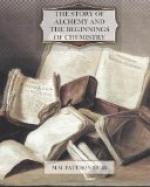Lavoisier made a series of experiments. The results were these: there was no change in the total weight of the apparatus and its contents; when the vessel was opened after the calcination was finished, air rushed in, and the whole apparatus now weighed more than it did before the vessel was opened; the weight of the air which rushed in was exactly equal to the increase in the weight of the tin produced by the calcination, in other words, the weight of the inrushing air was exactly equal to the difference between the weights of the tin and the calx formed by calcining the tin. Lavoisier concluded that to calcine tin is to cause it to combine with a portion of the air wherein it is calcined. The weighings he made showed that about one-fifth of the whole weight of air in the closed flask wherein he calcined tin had disappeared during the operation.
Other experiments led Lavoisier to suspect that the portion of the air which had united with the tin was different from the portion which had not combined with that metal. He, therefore, set himself to discover whether there are different kinds of “airs” in the atmosphere, and, if there is more than one kind of “air,” what is the nature of that “air” which combines with a metal in the process of calcination. He proposed to cause a metallic calx (that is, the substance formed by calcining a metal in the air) to give up the “air” which had been absorbed in its formation, and to compare this “air” with atmospheric air.
About this time Priestley visited Paris, saw Lavoisier, and told him of the new “air” he had obtained by heating calcined mercury. Lavoisier saw the great importance of Priestley’s discovery; he repeated Priestley’s experiment, and concluded that the air, or gas, which he refers to in his Laboratory Journal as “l’air dephlogistique de M. Priestley” was nothing else than the purest portion of the air we breathe. He prepared this “air” and burned various substances in it. Finding that very many of the products of these combustions had the properties of acids, he gave to the new “air” the name oxygen, which means the acid-producer.




